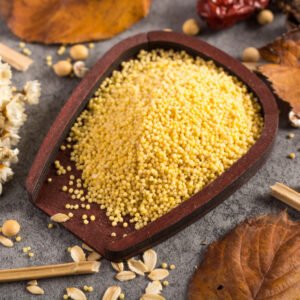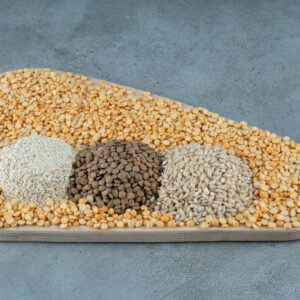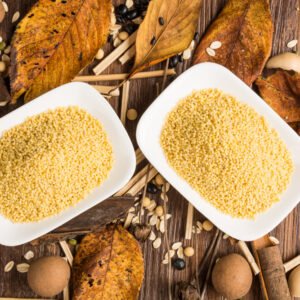When I first started learning about rice varieties, the difference between raw rice vs. steam rice completely puzzled me.
You know that moment when you’re standing in the grocery aisle, staring at two identical-looking packets of rice?
One says “raw rice” and the other says “steam rice” and you’re thinking, “Aren’t they both just rice?”
Trust me, I’ve been there too. Today, I’m going to break down everything you need to know about raw rice and steam rice. By the end of this article, you’ll understand exactly which one suits your cooking style, health goals, and taste preferences.
What Exactly Is Raw Rice?
Raw rice is basically rice in its most natural form after being hulled and polished. Think of it as rice that hasn’t been given any special treatment during processing. The grains go through minimal processing – just enough to remove the outer husk and make them edible.
Key characteristics of raw rice:
- Harder texture when cooked
- Takes longer cooking time (usually 20-25 minutes)
- Absorbs more water during cooking
- Has a slightly nutty flavour
- Grains tend to separate easily after cooking
In India, raw rice is what our grandmothers traditionally used for making everyday meals.
It’s the go-to choice for dishes like pulao, fried rice, and even for making rice flour at home.
Understanding Steam Rice Processing
Steam rice, on the other hand, gets a special treatment before it reaches your kitchen. During processing, the paddy (rice with husk) is steamed under pressure, then dried and milled. This steaming process is what makes all the difference.
What happens during steaming:
- Steam penetrates the grain
- Nutrients from the bran layer get pushed into the grain
- The starch structure changes
- Grains become harder and less likely to break
Key characteristics of steam rice:
- Softer texture when cooked
- Cooks faster (around 15-18 minutes)
- Absorbs less water
- Has a milder taste
- Slightly yellowish tint due to steaming
Nutritional Comparison: Which One Wins?
Here’s where things get interesting. You might think raw rice is more nutritious because it’s “less processed.” But steam rice actually has some nutritional advantages.
Steam Rice Nutritional Benefits:
- Higher vitamin B1 (thiamine) – the steaming process drives nutrients from the bran into the grain
- Better mineral retention – calcium, potassium, and magnesium levels are higher
- Improved protein quality – steaming makes proteins more digestible
- Lower glycemic index – better for blood sugar management
Raw Rice Nutritional Profile:
- Natural fibre content – though minimal after polishing
- No processing modifications – appeals to those preferring minimal processing
- Standard mineral content – typical levels for polished rice
The winner? Steam rice edges ahead nutritionally, especially for diabetics and health-conscious individuals.
Cooking Differences That Actually Matter
I’ve cooked both varieties hundreds of times, and the cooking differences are significant.
Raw Rice Cooking Tips:
- Water ratio: 1:2.5 (1 cup rice to 2.5 cups water)
- Soaking time: 20-30 minutes for better texture
- Cooking time: 22-25 minutes
- Best for: Pulao, biryani, fried rice
Steam Rice Cooking Tips:
- Water ratio: 1:2 (1 cup rice to 2 cups water)
- Soaking time: 10-15 minutes (optional)
- Cooking time: 15-18 minutes
- Best for: Daily meals, sambar rice, rasam rice
Pro tip: Steam rice is more forgiving for beginners because it’s harder to overcook.
Taste and Texture: The Real Game Changer
This is where personal preference really kicks in. Raw rice gives you that traditional, authentic rice experience. The grains have more bite, more texture, and a subtle nutty flavour that pairs beautifully with spicy Indian curries. Steam rice offers a softer, more tender eating experience. It’s milder in taste, which makes it perfect for absorbing the flavours of whatever you’re eating it with.
When I choose raw rice:
- Making special occasion dishes like biryani
- Want grains to stay separate and firm
- Cooking for people who prefer traditional textures
- Making rice-based snacks or breakfast items
When I choose steam rice:
- Daily family meals
- Cooking for elderly family members (easier to digest)
- Quick weeknight dinners
- Want rice that blends well with curries
Storage and Shelf Life Differences
Both varieties store similarly, but there are subtle differences.
Raw rice storage:
- Slightly longer shelf life (up to 2 years when stored properly)
- Less prone to rancidity
- Can handle temperature variations better
Steam rice storage:
- Good shelf life (18-24 months)
- Store in cool, dry places
- Slightly more sensitive to moisture due to processing
Cost Factor: What to Expect
Generally, steam rice costs slightly more than raw rice. The additional processing steps and equipment required for steaming add to the production costs. However, the price difference is usually minimal – maybe ₹2-5 per kilogram.
At CMS Industries, we focus on providing both varieties at competitive prices while maintaining the highest quality standards. Our direct sourcing from trusted mills ensures you get authentic, adulteration-free rice regardless of which variety you choose.
Which One Should You Choose?
Here’s my honest recommendation based on different scenarios:
Choose raw rice if:
- You’re making special dishes like biryani or pulao
- You prefer traditional textures and flavours
- You’re comfortable with longer cooking times
- You want rice grains that stay separate
Choose steam rice if:
- You’re looking for daily-use rice for regular meals
- You want faster cooking times
- You prefer softer textures
- You’re health-conscious (better nutritional profile)
- You’re cooking for elderly family members
For most Indian households, I recommend keeping both varieties.
Use steam rice for everyday meals and raw rice for special occasions and specific dishes.
Common Myths About Raw Rice vs. Steam Rice
Let me clear up some misconceptions I often hear:
Myth 1: “Raw rice is always healthier because it’s less processed.” Reality: Steam rice actually has better nutrient retention due to the steaming process.
Myth 2: “Steam rice is artificial or chemically treated.” Reality: Steaming is a natural process using only steam and pressure – no chemicals involved.
Myth 3: “You can use them interchangeably in any recipe.” Reality: Different dishes work better with specific rice types due to texture and cooking behaviour differences.
Regional Preferences Across India
Different regions in India have strong preferences based on traditional cooking methods:
South India: Predominantly prefers steam rice for daily meals, especially for dishes like sambar rice and curd rice.
North India: Uses both varieties extensively – raw rice for biryanis and pulavs, steam rice for regular meals.
East India: Traditional preference for steam rice, especially in Bengali cuisine.
West India: Mixed usage based on specific regional dishes and family traditions.
Quality Indicators for Both Types
Whether you’re buying raw rice or steam rice, here’s what to look for:
Visual inspection:
- Uniform grain size and colour
- Minimal broken grains
- No discoloration or spots
- Clean appearance without debris
Texture test:
- Grains should feel firm, not soft or mushy
- No excessive powder or dust
- Good grain separation
Aroma check:
- Fresh, clean smell
- No musty or off odours
- Natural rice fragrance
At CMS Industries, we ensure all our rice varieties undergo rigorous quality control measures.
Our Sona Masoori varieties, both raw and steam, are sourced directly from trusted mills and processed with the highest hygiene standards.
Conclusion
Understanding the difference between raw rice vs. steam rice isn’t just about cooking it’s about making informed choices for your family’s nutrition and preferences. Steam rice offers better nutrition, faster cooking, and softer texture perfect for daily meals. Raw rice provides traditional texture, longer shelf life, and works beautifully for special dishes.
The best approach? Keep both in your kitchen and use them based on what you’re cooking. Whether you choose raw rice, steam rice, or both, the key is selecting high-quality grains from trusted sources. That’s exactly what we focus on at CMS Industries – delivering premium quality rice varieties that meet your family’s diverse needs while maintaining the authentic taste and nutrition you deserve.
The choice between raw rice vs. steam rice ultimately comes down to your cooking style, health goals, and taste preferences.
Frequently Asked Questions
Q:1 Can I substitute steam rice for raw rice in biryani recipes?
While possible, raw rice works better for biryani as it maintains grain separation and provides the traditional texture. Steam rice may result in softer, less distinct grains.
Q2: Which type of rice is better for diabetics?
Steam rice has a lower glycemic index due to the steaming process, making it a slightly better choice for blood sugar management compared to raw rice.
Q:3 Does steam rice take less time to cook than raw rice?
Yes, steam rice typically cooks 5-7 minutes faster than raw rice due to the pre-steaming process that partially gelatinizes the starch during processing.
Q:4 Why does steam rice have a yellowish colour?
The slight yellow tint comes from the steaming process where natural compounds from the bran layer get infused into the grain during processing.
Q:5 Which rice variety stays fresh longer in storage?
Raw rice generally has a slightly longer shelf life (up to 2 years) compared to steam rice (18-24 months) when stored properly in cool, dry conditions.





